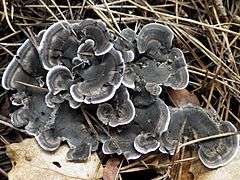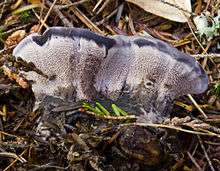Phellodon niger
Phellodon niger, commonly known as the black tooth,[2] is a species of tooth fungus in the family Bankeraceae, and the type species of the genus Phellodon. It was originally described by Elias Magnus Fries in 1815 as a species of Hydnum.[3] Petter Karsten included it as one of the original three species when he circumscribed Phellodon in 1881.[4] The fungus is found in Europe and North America, although molecular studies suggest that the North American populations represent a similar but genetically distinct species.
| Phellodon niger | |
|---|---|
 | |
| Scientific classification | |
| Kingdom: | |
| Division: | |
| Class: | |
| Order: | |
| Family: | |
| Genus: | |
| Species: | P. niger |
| Binomial name | |
| Phellodon niger | |
| Synonyms[1] | |
| |
Taxonomy
Phellodon niger was originally described by Swedish mycologist Elias Fries in 1815 as a species of Hydnum.[3] The genus Phellodon was circumscribed in 1881 by Finnish mycologist Petter Karsten to contain white-toothed fungi. Karsten included three species: P. cyathiformis, P. melaleucus, and the type, P. niger (originally published with the epithet "nigrum").[4]
The variety Phellodon niger var. alboniger, published by Kenneth Harrison in 1961,[5] is considered synonymous with Phellodon melaleucus.[6] Lucien Quélet's 1886 Calodon niger[7] is a synonym of Phellodon niger.[1] Taxonomic synonyms (i.e., based on a different type) include: Hydnum olidum (Berkeley, 1877); Hydnum cuneatum (Lloyd 1925); and Hydnum confluens (Peck 1874).[8] The DNA sequences of the internal transcribed spacer regions of collections from the United Kingdom were compared with collections made in the Southern United States. They showed a 92–93% similarity, suggesting that the North American populations are a different species with very similar morphological characteristics.[8]
Phellodon niger is commonly known as the "black scented spine fungus",[9] and the "black tooth".[2]
Description

Fruitbodies of Phellodon niger have a cap and a stipe, and so fall into the general class of "stipitate hydnoid fungi". Individual caps are up to 5 cm (2.0 in) in diameter, but caps of neighboring fruitbodies often fuse together to create larger compound growths. Caps are flat to depressed to somewhat funnel-shaped, with a felt-like texture at first before developing concentric pits, wrinkles, and ridges. Initially whitish (sometimes with purplish tints), the cap later darkens in the center to grey, grey-brown, or black. The stipe, measuring up to 4 cm (1.6 in) long, is roughly the same color as the cap. On the underside of the caps are grey spines, up to 4 mm long.[9] The outer covering of the stipe is a thick felty layer of mycelium that absorbs water like a sponge. In conditions of high humidity, P. niger can form striking drops of black liquid on the actively growing caps.[5] The flesh has an odor of fenugreek when it is dry.[9] The mushroom tissue turns bluish-green when tested with a solution of potassium hydroxide.[8]
The ellipsoid, hyaline (translucent) spores measure 3.5–5 by 3–4 µm. The basidia (spore-bearing cells) are club-shaped, four-spored, and measure 25–40 by 5–7 µm. Phellodon niger has a monomitic hyphal system, producing generative hyphae with a diameter of 2.5–5 µm.[9]
Habitat and distribution
The ectomycorrhizae that P. niger forms with Norway spruce (Picea abies) has been comprehensively described. It is distinguished from the ectomycorrhizae of other Thelephorales species by the unique shape of its chlamydospores.[10] Stable isotope ratio analysis of the abundance of the stable isotope carbon-13 shows that P. niger has a metabolic signature close to that of saprotrophic fungi, indicating that it may be able to obtain carbon from sources other than a tree host.[11][12]
Phellodon niger is found in continental Europe, where it has a widespread distribution,[9] and in North America. In a preliminary assessment for a red list of threatened British fungi, P. niger is considered rare.[13] In Switzerland, it is considered a vulnerable species.[14] Phellodon niger was included in a Scottish study to develop species-specific PCR primers that can be used to detect the mycelia of stipitate hydnoids in soil.[15] Collections labelled as P. niger from the United Kingdom that were DNA tested, revealed additional cryptic species.[16][17] Analysis using PCR can determine the presence of a Phellodon species up to four years after the appearance of fruitbodies, allowing a more accurate determination of their possible decline and threat of extinction.[18]
Chemistry
Phellodon niger has been a source for several bioactive compounds: the cyathane-type diterpenoids, nigernin A and B; a terphenyl derivative called phellodonin (2',3'-diacetoxy-3,4,5',6',4''-pentahydroxy-p-terphenyl); grifolin; and 4-O-methylgrifolic acid.[19] Additional nigernins (C through F) were reported in 2011.[20]
Fruitbodies are used to make a gray-blue or green dye.[21]
References
- "GSD Species Synonymy: Phellodon niger (Fr.) P. Karst". Species Fungorum. CAB International. Retrieved 2015-09-09.
- Holden L. (July 2014). "English Names for fungi 2014". British Mycological Society. Retrieved 2015-11-11.
- Fries EM. (1815). "Observationes mycologicae" (in Latin). 1. Copenhagen: Gerhard Bonnier: 134. Cite journal requires
|journal=(help) - Karsten PA. (1881). "Enumeratio Hydnearum Fr. Fennicarum, systemate novo dispositarum". Revue mycologique, Toulouse (in Latin). 3 (9): 19.
- Harrison KA. (1961). The Stipitate Hydnums of Nova Scotia. Publications of the Department of Agriculture Canada (Report). 1099. Ottawa, Canada: Research Branch, Canada Department of Agriculture. pp. 1–60 (see p. 15).

- "Record Details: Phellodon niger var. alboniger (Peck) K.A. Harrison". Index Fungorum. CAB International. Retrieved 2015-09-21.
- Quélet L. (1886). Enchiridion Fungorum in Europa media et praesertim in Gallia Vigentium (in Latin). Lutetia: Octave Dion. p. 191.
- Baird RE, Wallace LE, Baker G, Scruggs M (2013). "Stipitate hydnoid fungi of the temperate southeastern United States". Fungal Diversity. 62 (1): 41–114. doi:10.1007/s13225-013-0261-6.
- Pegler DN, Roberts PJ, Spooner BM (1997). British Chanterelles and Tooth Fungi. Kew, UK: Royal Botanic Gardens. p. 45. ISBN 978-1-900347-15-0.
- Agerer R. (1992). "Ectomycorrhizae of Phellodon niger on Norway spruce and their chlamydospores". Mycorrhiza. 2 (1): 47–52. doi:10.1007/BF00206283.
- Högberg P, Plamboeck AH, Taylor AF, Fransson PM (1999). "Natural C-13 abundance reveals trophic status of fungi and host-origin of carbon in mycorrhizal fungi in mixed forests". Proceedings of the National Academy of Sciences of the United States of America. 96 (15): 8534–8539. doi:10.1073/pnas.96.15.8534. PMC 17551. PMID 10411910.

- Taylor AF, Fransson PM, Högberg P, Högberg MN, Plamboeck AH (2003). "Species level patterns in C-13 and N-15 abundance of ectomycorrhizal and saprotrophic fungal sporocarps". New Phytologist. 159 (3): 757–774. doi:10.1046/j.1469-8137.2003.00838.x.

- Bridge PD, Panchal G (2004). Number 557. Population diversity and speciation in Hydnellum and Phellodon species (PDF) (Report). English Nature Research Reports. English Nature. ISSN 0967-876X.
- Senn-Irlet B, Bieri G, Egli S (2007). Lista Rossa Macromiceti. Lista Rossa delle specie minacciate in Svizzera. UV-0718-I (Report) (in Italian). Bern: Ufficio federale dell’ambiente.
- Van der Linde S, Alexander I, Anderson IC (2008). "A PCR-based method for detecting the mycelia of stipitate hydnoid fungi in soil". Journal of Microbiological Methods. 75: 40–46. doi:10.1016/j.mimet.2008.04.010. PMID 18586344.
- Parfitt D, Ainsworth AM, Simpson D, Rogers HJ, Boddy L (2007). "Molecular and morphological discrimination of stipitate hydnoids in the genera Hydnellum and Phellodon". Mycological Research. 111 (7): 761–777. doi:10.1016/j.mycres.2007.05.003. PMID 17681224.
- Ainsworth AM, Parfitt D, Rogers HJ, Boddy L (2010). "Cryptic taxa within European species of Hydnellum and Phellodon revealed by combined molecular and morphological analysis". Fungal Ecology. 3 (2): 65–80. doi:10.1016/j.funeco.2009.07.001.
- van der Linde S, Holden E, Parkin PI, Alexander IJ, Anderson IC (2012). "Now you see it, now you don't: The challenge of detecting, monitoring and conserving ectomycorrhizal fungi". Fungal Ecology. 5 (5): 633–640. doi:10.1016/j.funeco.2012.04.002.
- Fang ST, Zhang L, Li ZH, Li B, Liu JK (2010). "Cyathane diterpenoids and nitrogenous terphenyl derivative from the fruiting bodies of basidiomycete Phellodon niger" (PDF). Chemical and Pharmaceutical Bulletin. 58 (9): 1176–1179. doi:10.1248/cpb.58.1176. PMID 20823596. Archived from the original (PDF) on 2015-09-28. Retrieved 2015-09-27.
- Fang ST, Feng T, Zhang L, Dong ZJ, Li ZH, Liu JK (2011). "Cyathane diterpenoids from fruiting bodies of Phellodon niger". Natural Products and Bioprospecting. 1 (1): 37–40. doi:10.1007/s13659-011-0002-z. PMC 4131705.

- Roberts P, Evans S (2011). The Book of Fungi. Chicago, Illinois: University of Chicago Press. p. 474. ISBN 978-0-226-72117-0.
External links
| Wikimedia Commons has media related to Phellodon niger. |